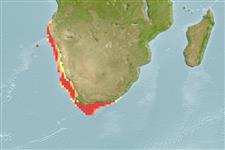Lớp phụ Cá sụn (cá mập và cá đuối) (sharks and rays) >
Carcharhiniformes (Ground sharks) >
Scyliorhinidae (Cat sharks) > Scyliorhininae
Etymology: Scyliorhinus: skylion, Greek for dogfish or small shark; rhinus, from rhine (Gr.), rasp, alluding to a shark’s jagged, rasp-like skin (See ETYFish); capensis: -ensis, Latin suffix denoting place: Cape of Good Hope, South Africa, type locality (See ETYFish).
More on authors: Müller & Henle.
Environment: milieu / climate zone / depth range / distribution range
Sinh thái học
Biển gần đáy; Mức độ sâu 26 - 495 m (Ref. 5578). Subtropical; 0°S - 37°S, 0°W - 29°E (Ref. 57015)
Southeast Atlantic: Lüderitz, Namibia to central Natal, South Africa.
Length at first maturity / Bộ gần gũi / Khối lượng (Trọng lượng) / Age
Maturity: Lm 69.0, range 68 - 70 cm
Max length : 122 cm TL con đực/không giới tính; (Ref. 244)
Short description
Khóa để định loại | Hình thái học | Sinh trắc học
Các tia vây lưng cứng (tổng cộng) : 0; Tia cứng vây hậu môn: 0. Bright yellow or golden spots on a dark grey body with irregular blotches and saddles (Ref. 5578), cream below (Ref. 5510); 2nd dorsal much smaller than 1st (Ref. 5578). Small anterior nasal flaps that do not reach mouth, no nasoral grooves (Ref. 244).
A common inshore to offshore catshark. Prefers to feed on small bony fishes and crustaceans, also cephalopods (Ref. 244). Oviparous (Ref. 50449).
Oviparous, with a single egg per oviduct at a time (Ref. 244). Oviparous, paired eggs are laid. Embryos feed solely on yolk (Ref. 50449). Size upon hatching below 31 cm (size of young with umbilical scars) (Ref. 244).
Compagno, L.J.V., 1984. FAO Species Catalogue. Vol. 4. Sharks of the world. An annotated and illustrated catalogue of shark species known to date. Part 2 - Carcharhiniformes. FAO Fish. Synop. 125(4/2):251-655. Rome: FAO. (Ref. 244)
IUCN Red List Status (Ref. 130435: Version 2024-1)
Threat to humans
Harmless
Human uses
Các nghề cá: không ích lợi (thú vị); cá để chơi: đúng
Các công cụ
Special reports
Download XML
Các nguồn internet
Estimates based on models
Preferred temperature (Ref.
123201): 9.3 - 16.5, mean 12.2 °C (based on 45 cells).
Phylogenetic diversity index (Ref.
82804): PD
50 = 0.5000 [Uniqueness, from 0.5 = low to 2.0 = high].
Bayesian length-weight: a=0.00263 (0.00138 - 0.00502), b=3.21 (3.04 - 3.38), in cm total length, based on LWR estimates for this (Sub)family-body shape (Ref.
93245).
Mức dinh dưỡng (Ref.
69278): 4.0 ±0.5 se; based on diet studies.
Thích nghi nhanh (Ref.
120179): Rất thấp, thời gian nhân đôi của chủng quần tối thiểu là hơn 14 năm (Fec = 1).
Fishing Vulnerability (Ref.
59153): High to very high vulnerability (73 of 100).
